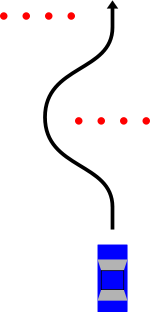
The evasive manoeuvre test (Swedish: Undanmanöverprov; colloquial: moose test or elk test; Swedish: Älgtest, German: Elchtest) is performed to determine how well a certain vehicle evades a suddenly appearing obstacle. This test has been standardized in ISO 3888-2.[1]
Forms of the test have been performed in Sweden since the 1970s.[2] The colloquial and internationally better-known name for the test was coined in 1997 by the German newspaper Süddeutsche Zeitung after the Swedish motor magazine Teknikens Värld together with the TV-show Trafikmagasinet flipped a First generation Mercedes-Benz A-Class in a test ostensibly made to measure the car's ability to avoid hitting a moose.
In reality, the test is constructed to simulate, for example, a reversing car or a child rushing out onto the road.[3][4] This is because it is more likely that the moose will continue across the road than remain in place or turn back, making it more advisable to brake hard and try to slip behind the animal than to swerve in front of it.[5]
- ^ "VEHICO Fahrroboter - Index".
- ^ Cite error: The named reference
jeepwas invoked but never defined (see the help page). - ^ Andersson, Sven-Erik (14 April 1998). "Så bra är de nya sommardäcken". Aftonbladet (in Swedish). Archived from the original on 22 November 2009. Retrieved 12 July 2012.
Aldrig tidigare har däck testats i "älgtest" – det test som fick Mercedes A-klass på fall. 40 meters körning mellan koner, och en tvär undanmanöver, som simulerar att till exempel ett barn (inte en älg) plötsligt kommer utspringande framför bilen." / "Never before have tyres been tested in "the moose test" - the test that brought down the Mercedes A-class. 40 meters of driving through cones, and a sharp evasive manoeuvre, that for example simulates a child (not a moose) suddenly rushing in front of the car.
- ^ Collin, Robert (15 November 2004). "Vältklassen". Aftonbladet (in Swedish). Archived from the original on 12 December 2013. Retrieved 12 July 2012.
- ^ "Trafikolyckor & olycksstatistik". Körkortonline.se (in Swedish). Retrieved 13 July 2013.
När en älg väl har börjat gå över vägen är sannolikheten störst att den fortsätter över vägen. Därför är det bäst att styra in bakom älgen, om du måste välja vilket håll du ska väja åt." / "When a moose has begun to cross the road, it is likely that it will continue across. Therefore it is best to steer behind the moose, if you have to choose what way to swerve.